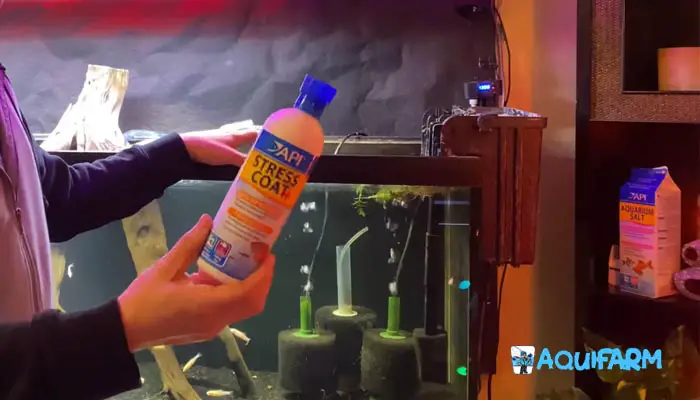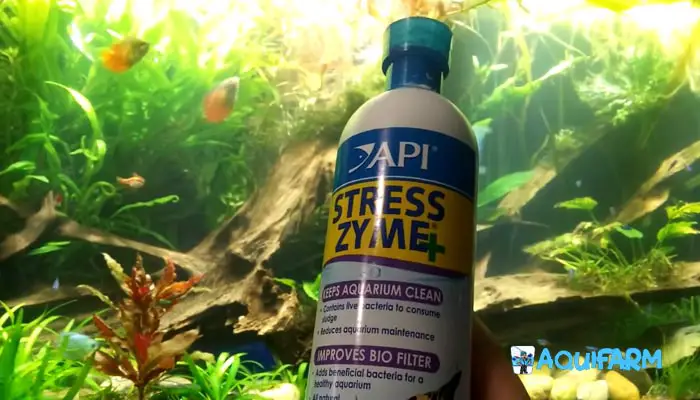Stress Coat or Stress Zyme: Which One To Choose?
Stress Coat and Stress Zyme are two proven aquarium products from API. Both do different jobs exceptionally well, which is why choosing between Stress Coat or Stress Zyme can feel confusing.
Before you decide, understand their roles: Stress Coat is a water conditioner that neutralizes chlorine and chloramine and detoxifies heavy metals. Stress Zyme is a biological cleaner that adds beneficial bacteria to break down organic waste and sludge.
Stress Coat also supports slime-coat protection (with aloe vera) to help reduce fish stress and promote healing. Stress Zyme reduces maintenance by improving biological breakdown of wastes—supporting a more stable, low-ammonia environment when paired with proper filtration and water changes.
In this post, you’ll get a clear view of each product’s functions, benefits, dosing schedules, and best-use scenarios so you can choose confidently (or use both together correctly).
Stress Coat Vs Stress Zyme — Quick Comparison
| Features | Stress Coat | Stress Zyme |
| Function | Neutralizes chlorine + chloramine; detoxifies heavy metals; supports fish slime coat | Adds beneficial bacteria to break down organic waste/sludge and support bio-cleaning |
| Application per 10 Gallons | 5 mL (double dose for slime-coat repair or after netting/transport) | 5 mL weekly for established tanks; 10 mL for new tanks during initial setup period |
| Key Benefits | Aloe vera to reduce stress; promotes healing of skin/fins; safe for fresh & saltwater | Keeps surfaces cleaner; boosts filter efficiency; reduces maintenance frequency |
| What It Uses | Conditioners + aloe vera | Live, non-pathogenic bacteria (e.g., Bacillus blend) |
Differences Between Stress Coat and Stress Zyme — In Details
To pick the right product, match what it does to what your tank needs. Here’s how they differ and when to use each.
Functions
Stress Coat

Stress Coat is a water conditioner. It chemically neutralizes chlorine and chloramine in tap water and detoxifies heavy metals so they can’t harm fish or invertebrates. Use it for every water change, when adding new fish, and after medication or netting to replace the protective slime coat.
Tap water is disinfected with chlorine or chloramine. These do not “filter out,” and letting water sit may off-gas chlorine but does not remove chloramine. A conditioner like Stress Coat is the reliable solution—it works within minutes as water circulates.
Bonus: aloe vera helps reduce stress and supports tissue/fin recovery, making fish more resilient during changes.
Stress Zyme

Stress Zyme is a biological cleaner. Each 5 mL dose contains hundreds of millions of beneficial bacteria that help digest organic waste (uneaten food, fish waste, and sludge) on surfaces and in the substrate. This reduces grime, supports filter performance, and can make regular maintenance easier.
Note: Stress Zyme is not a dechlorinator and isn’t a replacement for nitrifying bacteria products used to instantly cycle a tank. It supports the overall biological balance and cleanliness alongside your filter and water-change routine.
Usage
Stress Coat
Use whenever you add tap water (water changes, top-ups) and when introducing new fish. It’s also helpful after netting/transport or medication to support slime-coat recovery.
After dosing, allow a few minutes of circulation for even mixing. You don’t need to “wait hours” to add fish—condition first, then add fish to the treated water.
If your source water has persistent chlorine/chloramine or you keep sensitive species, dose consistently at every change.
Stress Zyme
Dose weekly to keep surfaces cleaner, and use during new-tank setup to help establish a robust bacterial community. For best results, turn off UV sterilizers/ozone for 24 hours after dosing so the bacteria can colonize. Maintain normal filtration and aeration.
If weekly use doesn’t keep up, your tank may be overstocked or overfed—adjust bioload and feeding rather than over-dosing bacteria.
Always follow label directions; overuse of any additive can upset balance. Water changes and filtration remain essential.
Application Procedure
Stress Coat
Apply correctly for instant, safe dechlorination:
- Purchase the bottle size matched to your tank. Check the manufacturing/expiry dates.
- Use a clean measuring cup (glass/silicone) dedicated to aquarium use.
- Dose: 5 mL per 10 U.S. gallons (38 L). Double dose when replacing slime coat (after netting/transport or visible fin/skin damage).
- Add directly to the new water bucket before it goes into the tank, or dose the tank immediately before/while refilling. Circulate for a few minutes.
Precautions:
For ornamental fish only. Keep out of reach of children. Store at room temperature. Avoid mixing with oxidizers (e.g., peroxide/permanganate) at the same time.
Stress Zyme
Apply to establish and maintain a clean, biologically balanced tank:
- Buy from a reputable source; shake the bottle well before each use.
- Dose: New tanks — 10 mL per 10 gallons. Established tanks — 5 mL per 10 gallons weekly.
- Add directly to the tank after feeding. Turn off UV/ozone for ~24 hours so bacteria can settle.
Precautions:
This is a live-bacteria product (biological additive), not a water conditioner. Avoid eye/skin contact, don’t ingest, store cool and out of direct sunlight, and keep away from children.
Benefits
Stress Coat
- Neutralizes chlorine/chloramine and detoxifies heavy metals
- Contains aloe vera to help reduce stress and support recovery
- Protects slime coat; promotes healing of skin/fins
- Helps prevent electrolyte loss during stress events
- Suitable for freshwater and saltwater aquariums
Stress Zyme
- Keeps aquariums cleaner by digesting organic sludge
- Supports a natural biological balance; boosts filter effectiveness
- Contains ~300 million live bacteria per teaspoon (≈5 mL)
- Reduces maintenance frequency when combined with proper husbandry
- Safe for freshwater and saltwater use
Which One to Choose: Stress Coat or Stress Zyme?
They solve different problems and can be used together. Use Stress Coat for every water change, top-up, and fish introduction to make tap water safe and support slime coat. Use Stress Zyme weekly to help break down organic waste and keep surfaces cleaner.
If you must pick one: choose Stress Coat if your priority is safe tap water and fish health during changes. Choose Stress Zyme if your priority is reducing sludge and keeping the tank cleaner between maintenance (but you’ll still need a separate water conditioner).
Always check species sensitivity, your budget, and tank needs. The cleanest water plus proper stocking and feeding will keep your livestock healthiest.
FAQs
How long does Stress Coat take to dechlorinate?
Conditioners like Stress Coat work within minutes as water circulates. Chlorine is neutralized quickly; chloramine is chemically neutralized (not off-gassed). You do not need to wait 24 hours—dose first, then add water/fish.
What happens if you put too much water conditioner in the tank?
Mild overdoses are usually safe, but gross overdosing can stress fish and the biofilter. Always follow the label and measure accurately. Using no conditioner with tap water is far riskier than a small overdose.
Does Stress Coat lower nitrites?
No. Stress Coat neutralizes chlorine/chloramine and detoxifies heavy metals; it does not remove nitrite. Control nitrite with water changes, proper cycling (nitrifying bacteria), and reasonable stocking/feeding.
Is API Stress Zyme a water conditioner?
No. Stress Zyme is a biological additive (beneficial bacteria) that helps digest organic waste and keep the tank cleaner. You still need a separate water conditioner—such as Stress Coat—to treat tap water.
Can you use Stress Coat and aquarium salt together?
Yes—Stress Coat can be used with aquarium salt. Dose salt cautiously and only when appropriate for your species and situation. Always replace only the amount of salt removed during water changes.
Final Words
Once you understand what each product does, choosing Stress Coat or Stress Zyme becomes straightforward. Use Stress Coat to make tap water safe and support fish health; use Stress Zyme weekly to help digest organic waste and reduce manual cleaning. Many aquarists run both for the best results.
Match the product to your goals and budget, follow the label, and keep up with regular maintenance. The cleaner and more stable your water, the healthier your aquatic life will be.
- How To Use Rockwool In Hydroponics – Your Aquarist’S Guide To Lush - December 5, 2025
- Rimworld Hydroponics Layout – Your Ultimate Guide To A Thriving Colony - December 5, 2025
- Hydroponics Townsville: Your Ultimate Guide To A Thriving Aquaponics - December 5, 2025
